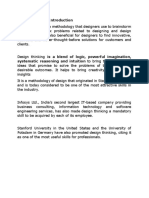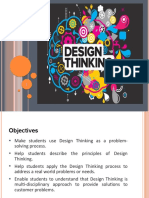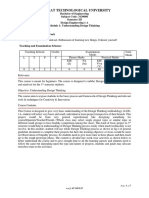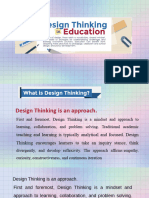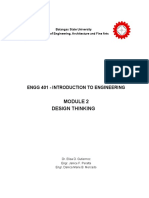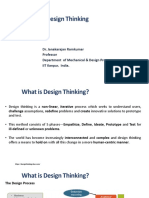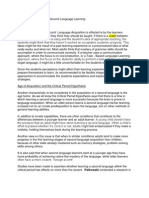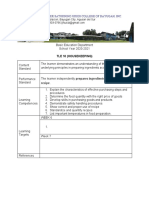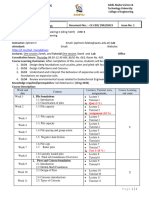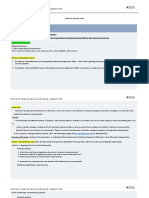Lesson 17 Strategy 9: Design thinking
Learning Outcomes
At the end of the lesson student will be able to;
1. Identify design thinking and understand its process.
2. Appreciate the importance of creativity and teamwork in solving problems through design thinking;
and
3. Apply design thinking in real-world problems
Introduction
Design thinking is a strategy that encourages students to solve problems creatively by thinking
like designers. It involves understanding a problem, coming up with ideas, trying out solutions and
improving them.
Engage
Activity 1. “Mystery box Challenge”
in this activity you will analyze various issues and challenges and provide
possible solution through mystery box.
Explore
Activity 2: “Design thinking Challenge”
In this activity the class will divided into two groups. Each group will identify problems in science
traditional classrooms, analyze why these problems exist and brainstorm and present your solution.
� Explain
What is Design Thinking?
Design thinking is a mind-set and an approach to learning, collaboration, and
problem-solving. It is a structured framework for identifying challenges, gathering
information, generating potential solutions, refining ideas, and testing solutions.
This approach has four characteristics:
1. Human-centered
It starts from having a deep compassion and understanding of people’s needs.
2. Collaborative
Solving problems is a lot easier and faster with several wise minds. It benefits from various
perspectives and insights.
3. Optimistic
It is an approach that believes in our potential to create a positive change in our lives no matter
what problems or difficulties could be hindering the task. It holds on to the primary idea that design
thinking is a worthy and enjoyable venture.
4. Experimental
It is an activity that gives room for mistakes and failure because from them, individuals learn and
become better. It is actually about learning by doing. Consequently, it is an approach that looks into new,
better, and creative way of improving our way of life and finding solutions to the many problems of the
society and people.
The Design Process
It is a structured approach for developing and applying ideas. It has five phases that help people identify
problems and develop creative and appropriate solutions to such problems. The five phases include:
�How to Use Design Thinking as a Teaching Strategy?
Before starting the design process, one should have a specific and intentional
problem to address that will be called a design challenge.
Design challenge are:
• List possible topics
• Frame the problem
• Keep it simple
• Sketch out end goals
• Define measures of success
• Establish constraints
• Write a brief
Plan your design project
1. Team
Design process is a collaborative effort. Select those people whom you trust and can help you
fulfill the goals of the project. Start small but invite variety. Choose people who have different insights and
perspectives.
2. Spaces
Choose a specific area where the team can meet regularly and work together.
3. Materials
Prepare all the necessary materials and accessories for the project.
Expound the five phases of design process.
A. Discovery
During this initial stage, the individual or the team is open for new ideas and opportunities. It h three
substages.
1. Understand the challenge
1.1 Review the challenge
1.2 Share what you know
1.3 Build your team
1.4 Define your audience
1.5 Refine your plan
2. Prepare research
2.1 Identify sources of inspiration
2.2 Select research participants
2.3 Build a question guide
2.4 Prepare for fieldwork
3. Gather inspiration
3.1 Immerse yourself in context
3.2 Seek inspiration in analogous settings
3.3 Learn from experts
3.4 Learn from users
�B. Interpretation
During this stage, ideas are transformed into meaningful insights.
1. Tell stories
2. Search for meaning
3. Frame opportunities
C. Ideation
It means the process of generating ideas. More ideas are formed as the team brainstorms.
1. Generate ideas
2. Refine ideas
D. Experimentation
1. Make prototypes
2. Get feedback
E. Evolution
Ideas evolve and improve over time. This stage allows envisioning the future and planning the next steps
and communicating with people who can help in the fulfillment of the project.
1. Track learnings
2. Move forward
Elaborate
Activity 3: “Design thinking in action”
In this activity you will work as a team to become creative problem solvers using design thinking
process, your group will choose a real-world problem and find a thoughtful, student-centered solution.
Instruction:
1. The class will be divided into 4-5 groups.
2. Each group must choose real-world problem that you want to solve.
3. Apply the 5 steps of the design thinking process.
4. Use a short presentation to show your process and solution
5. Each group will have 2 minutes to present their work
Evaluate
Multiple Choice. Encircle the best answer among the choices.
1. What is the first step in design thinking?
A. Prototype
B. Test
C. Empathize
D. Define
�2. Which step involves creating possible ideas?
A. Define
B. Ideate
C. Test
D. Empathize
3. What do you do in the TEST step?
A. Think of problems
B. Choose team members
C. Try out the solutions
D. Make rules
4. What is the main goal of design thinking?
A. Follow rules
B. Copy solutions
C. Solve real problems
D. Draw pictures
5. What should a group do after choosing a problem?
A. Make a game
B. Buy tools
C. Start the 5-step process
D. Watch a video
Summary
• Design thinking is a human-centered and creative approach to problem-solving that involves
understanding peoples need and working collaboratively to find effective solutions.
• The process follows five key phases: discovery, interpretation, ideation, experimentations
evolution.
• As a teaching strategy, it begins with identifying a clear design challenge, forming a team,
preparing materials, and engaging in hands-on learning. design thinking empowers students
to think critically, empathize, and create meaningful, real-world solutions.
Reference
Alata, EJ., and Alata, EJ., (2020). A course module for teaching strategies for elementary science
(physics, Earth, and Spcae Science). Rex bookstore
�Answer key:
Multiple choice
1. C
2. B
3. C
4. C
5. C


















